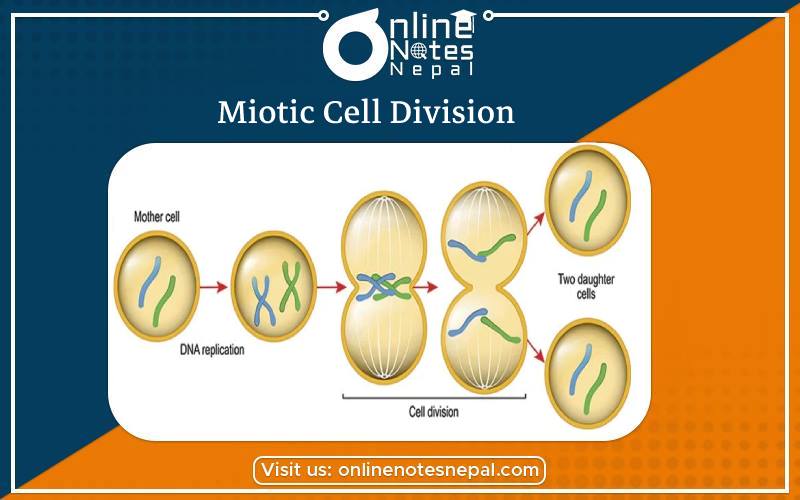Meiotic Cell Division
Meiotic Cell Division is the process in which a mother cell divides to form four daughter cells having the number of chromosomes of the mother cell.
The process in which a mother cell divides to form four daughter cells having the number of chromosomes half of that of the mother cell is called a meiotic cell division. It occurs in reproductive cells.
Homologous Pair: The identical male and female chromosome which makes a pair is called a homologous pair of the chromosome.
Synopsis: The process of the pairing of homologous chromosomes is called synapsis.
Crossing Over: The process of exchanging the hereditary materials between two non-sister chromatids of homologous pairs is called crossing over. It brings variation in the organisms.
Stages of Meiotic Cell Division
Meiosis completes into two successive divisions, they are:
- Meiosis - I
- Meiosis - II
1. Meiosis - I
It completes in four stages, they are:
a. Prophase-I
b. Metaphase-I
c. Anaphase-I
d. Telophase-I
a. Prophase-I
It is the initial and the longest stage of cell division. This stage is divided into five sub stage, they are:
i. Leptotene
ii. Zygotene
iii. Pachytene
iv. Diplotene
v. Diakinesis
i. Leptotene
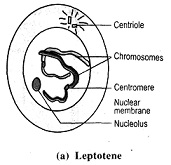
Characteristics
- The site of the cell and the nucleus increases at this stage.
- Bead-like chromosomes are seen in the middle of the chromosome when observed under a microscope.
- The chromosomes pair up but look like a single one.
- The nuclear membrane and nucleolus become distinct.
ii. Zygotene
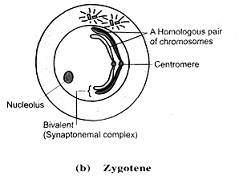
Characteristics
- Identical male and female chromosomes make a pair.
- Chromosomes are shorter and thicker.
- In each pair, one chromosome comes from paternal and other from maternal.
iii. Pachytene
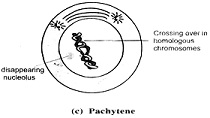
Characteristics
- It begins after the pairing of homologous chromosomes which are much shorter and thicker.
- At the end of this stage, homologous chromosomes split and a tetrad is formed.
- The exchange of hereditary materials or segments of chromosomes takes place.
iv. Diplotene
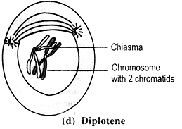
Characteristics
- The nuclear membrane begins to disappear.
- The chromosome becomes shortened and more coiled.
- Chromosomes begin to split by repulsive force and make contact at certain points called chiasmata.
- Chiasmata move away from centromere with the increase in its breadth.
Chiasmata: It is the point of contact between two non-sister chromatids of homologous pairs.
v. Diakinesis
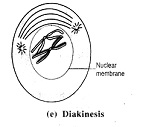
Characteristics
- Chromosomes are shorter and thicker.
- The chiasma moves towards the end of the chromosome. The shifting of chiasmata towards the end of the chromosome is called terminalization.
- The nuclear membrane and nucleus tend to disappear.
- Centrioles reach towards the opposite poles and spindle fibers begin to form.
b. Metaphase-I
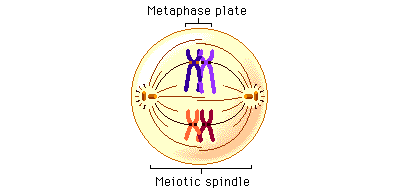
Characteristics
- The nuclear membrane disappears.
- Centriole reaches the equatorial plane.
- Spindle fibers attach with the centromere of the chromosome.
- Pairs of homologous chromosomes lie in the middle.
c. Anaphase-I
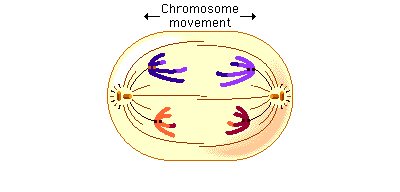
Characteristics
- Homologous pair separate from each other and move towards the opposite poles of the cell.
- The real reduction takes place at this stage because the chromosome number of the daughter nuclei formed is reduced to half than in the mother cell.
d. Telophase-I
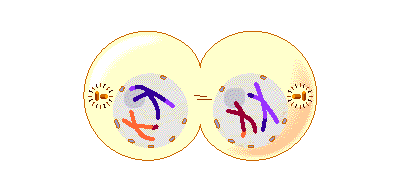
Characteristics
- The nucleous are formed in each pole which are haploid.
- Two daughter cells are formed by dividing the cell membrane or cell plate in cytokinesis.
- Meiosis-II begins after this stage.
2. Meiosis - II
It completes in four stages, they are:
a. Prophase-II
b. Metaphase-II
c. Anaphase-II
d. Telophase-II
a. Prophase-II
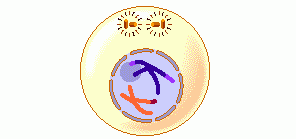
Characteristics
- While chromosome duplication took place prior to meiosis I, no new chromosome replication occurs before meiosis II.
- The centrioles duplicate. This occurs by separation of the two members of the pair, and then the formation of a daughter centriole perpendicular to each original centriole.
- The two pairs of centrioles separate into two centrosomes.
- The nuclear envelope breaks down, and the spindle apparatus forms.
b. Metaphase-II
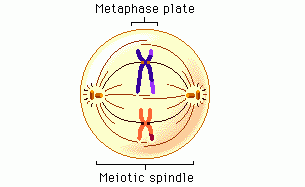
Characteristics
- Each of the daughter cells completes the formation of a spindle apparatus.
- Single chromosomes align on the metaphase plate, much as chromosomes do in mitosis.
- For each chromosome, the kinetochores of the sister chromatids face the opposite poles, and each is attached to a kinetochore-microtubule coming from that pole.
c. Anaphase-II
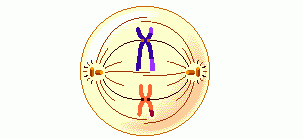
Characteristics
- The centromeres divide and the spindle fibers pull the chromatids to opposite poles.
- The separated chromatids are now called chromosomes in their own right.
- Four groups of chromosomes are formed at the end of Anaphase- II.
d. Telophase-II

